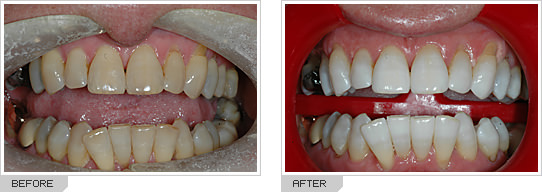Whitening (or bleaching) teeth is very often the quickest, simplest and cheapest way a person can enhance their smile.
Whitening is a chemical process that most commonly uses a carbamide peroxide gel to remove or alter chemical compounds in the enamel and dentine that cause our teeth to darken. The techniques we use today were developed in the mid 1980s and have shown themselves to be safe, predictable and effective. The most commonly used technique is one known as night guard vital bleaching, which involves placing tight fitting bespoke trays containing a relatively low dose carbamide peroxide gel on the teeth for around 14 nights until the desired result is achieved. Immediately after the home stage is complete the patient then attends for a surgery session of whitening that uses the same trays but a stronger gel to deepen and fix the results.
More recently “power bleaching” techniques have been developed to speed up the process. These techniques use stronger gels and heating lamps to speed up the chemical processes so patients can achieve near instant results. These techniques tend to be more expensive and tend not to achieve such dramatic results in the long term. A large portion of the whitening achieved by these results is due to dehydration of the teeth which reverses after 24 – 48 hours.
At the heart of all successful whitening techniques is a need to keep an appropriate concentration of gel in contact with the teeth for a sufficient number of hours to allow the chemical processes to take place. The darker the teeth are to begin with the longer this will take.

Advantages
- Relatively low cost – a whole smile for the price of one porcelain crown
- Relatively quick – 2 weeks usual treatment time for home whitening
- Non-invasive (no damage done to the teeth)
Disadvantages
- Potential Sensitivity (during process)
- Needs topping up every few months (done at home for a low cost)
Download a PDF of this page by clicking here.
(Requires Adobe Acrobat Reader – download it for free by clicking here)